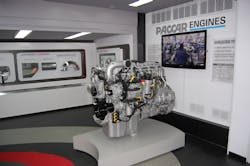LAS VEGAS. Enhancements to the MX-11 and MX-13 engines, a new proprietary tandem axle, and how integrating those components together with the trucks built by Kenworth Truck Co. and Peterbilt Motors Co. will drive efficiency improvements were the high points of a press event held here by PACCAR at the American Trucking Associations (ATA) annual conference.
Landon Sproull, vice president of powertrain for PACCAR and formerly chief engineer for Peterbilt, noted to reporters the company expects some 135,000 MX engines to be in operation in commercial trucks by year’s end, with the mix of MX displacements within Kenworth and Peterbilt orders at 50% or higher.
Sproull noted that 2017 model MX engines are getting several enhancements not only to comply with greenhouse gas (GHG) regulations but to deliver better “optimization” for Kenworth and Peterbilt truck customers:
- The MX-13 engine rating will increase to 510 hp and 1,850 lb.-ft. of torque, with a weight trim of 50 lbs. due to the use of a higher performance turbocharger;
- The rating for the MX-11 engine – introduced almost one year ago this week – jumps to 430 hp and 1,650 lb.-ft. of torque.
- The MX-11 also gets a new rating for the lower end of its power range: 335 hp and 1,150 lb.-ft. torque.
- A majority of the MX engine line’s ratings will deliver peak torque at 900 RPMs starting in January 2017, making them a better fit for downspeeding applications, said Sproull.
- Other design enhancements to the 2017 model MX-13 and MX-11 engines include a new single cylinder air compressor, variable displacement oil pump, and variable speed coolant pump.
- The MX engines will also come equipped with a new “single canister” aftertreatment system that reduces weight by 100 lbs.
- Oil and fuel filter change intervals for the MX-13 and MX-11 engines will be extended from 60,000 miles to 75,000 miles for the 2017 model year; an extension PACCAR believes will save up to $1,000 per truck over 600,000 miles of operation.
Sproull added that PACCAR conducted 2 million miles of testing with its enhanced 2017 model MX engines and based on oil analysis is “confident” in the new extended oil change intervals.
“We’ve seen less soot in the oil and less degradation; that’s why we’re confident in the extended interval,” he said.
Though the new 2017-compliant engines are expected to deliver better fuel economy compared to current products, Sproull would not say by how much.
“I don’t want to commit to a percentage just yet,” he said.
Sproull added that PACCAR is also currently testing the new FA-4 engine oil blend in its MX products and may decide to factory-fill with it once tests are completed by year’s end.
“I believe we’ll recommend both oils [CK-4 and FA-4] for 2013 model year engines and beyond but we need to finish our tests first,” he noted.
Sproull also provided insight into a new proprietary tandem axle PACCAR will begin offering on its Kenworth and Peterbilt branded trucks in January primarily for line haul, regional haul and pick-up and delivery customers.
The new axle is rated at 40,000 pounds, supporting a gross combination weight of 80,000 lbs., and is expected to shave 150 lbs. off of total vehicle weight.
Sproull noted that his new PACCAR axle features a pinion-through-shaft design that simplifies “power flow” and reduces weight by eliminating a gearing and attendant fasteners.
“Fewer gears means less loss of energy from the engine to the axle; that’s the tick to efficiency,” he explained.
Thus integrating the new tandem axle with PACCAR’s MX engines will help drive further fuel efficiency improvements for Kenworth and Peterbilt customers, he said.
PACCAR’s new tandem also axle comes with a five year/750,000 mile warranty and offers ratios from 2.47 to 3.70 with engine torque compatibility up to 1,650 ft.-lb. and multi-torque rating compatibility up to 1,750 ft.-lb.
About the Author
Sean Kilcarr
Editor in Chief
Sean Kilcarr is a former longtime FleetOwner senior editor who wrote for the publication from 2000 to 2018. He served as editor-in-chief from 2017 to 2018.

